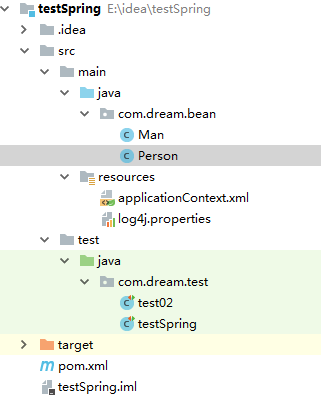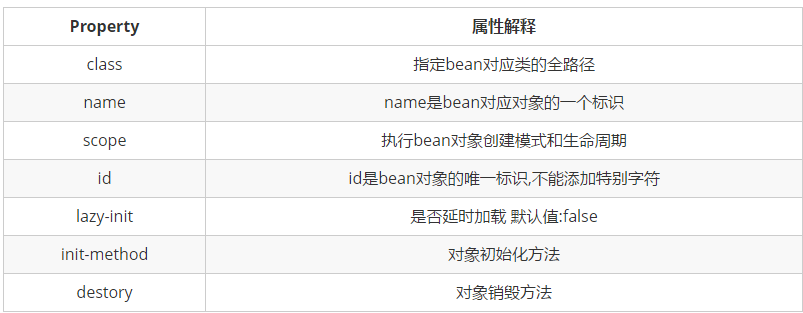1.概要:
在spring中,都是使用反射机制创建对象,将创建对象的权利交给spring容器,就是控制反转(ioc)
对象创建方式
- 有参构造
- 无参构造
- 工厂模式(静态,非静态)
2.创建IDEA控制台测试项目

3.导入依赖
日志依赖:log4j
测试依赖:junit
spring依赖:spring-context-support、core、context、expression、beans、test
4.创建resources
log4j.properties配置如下:
# log4J日志框架的配置文件 文件名字不能改
# DEBUG 表示日志的级别 调试
# Console 日志打印在控制台
log4j.rootLogger=DEBUG, Console
log4j.appender.Console=org.apache.log4j.ConsoleAppender
log4j.appender.Console.layout=org.apache.log4j.PatternLayout
log4j.appender.Console.layout.ConversionPattern=%d [%t] %-5p [%c] - %m%n
# 哪些日志需要打印
log4j.logger.java.sql.ResultSet=INFO
log4j.logger.org.apache=INFO
log4j.logger.java.sql.Connection=DEBUG
log4j.logger.java.sql.Statement=DEBUG
log4j.logger.java.sql.PreparedStatement=DEBUG
5.创建bean层
public class Person {
private Integer id;
private String name;
//无参,有参,getset,tostring
public Person() {
System.out.println("调用了无参构造");//方便观察如何调用的
}
public Person(Integer id, String name) { System.out.println("调用了有参构造。。")
this.id = id;
this.name = name;
}
public Integer getId() {
return id;
}
public void setId(Integer id) {
System.out.println("调用了setId");
this.id = id;
}
public String getName() {
return name;
}
public void setName(String name) {
System.out.println("调用了setName");
this.name = name;
}
@Override
public String toString() {
return "Person{" +
"id=" + id +
", name='" + name + '\'' +
'}';
}//静态工厂模式创建对象要单独在同一个bean中,新建一个类
package com.dream.bean; public class PersonFactory { public static Person createPerson(){ return new Person(3,"使用静态工厂创建p3....."); } }
//非静态工厂模式创建对象要单独新建一个类
package com.dream.bean; public class PFactory { public Person createPerson(){ return new Person(4,"使用非静态工厂创建p4....."); } }
6.创建spring容器创建对象的配置文件(建议使用applicationContext.xml命名)
<?xml version="1.0" encoding="UTF-8"?>
<beans xmlns="http://www.springframework.org/schema/beans"
xmlns:xsi="http://www.w3.org/2001/XMLSchema-instance"
xsi:schemaLocation="http://www.springframework.org/schema/beans
http://www.springframework.org/schema/beans/spring-beans.xsd">
<!--使用Spring的反射机制 创建对象-->
<!--1:默认调用无参数的构造方法-->
<!--2.调用有参数的构方法创建对象-->
<!--3.使用静态工厂创建对象-->
<!--4.使用非静态工厂创建对象-->
<!--1:默认调用无参数的构造方法-->
<bean id="p1" class="com.dream.bean.Person"> <property name="id" value="1"/> <property name="name" value="这是spring创建的第一个对象"/></bean>
<!--2.调用有参数的构造方法创建对象--><bean id="p2" class="com.dream.bean.Person"> <constructor-arg name="name" value="用index调整传入参数的顺序" index="1" /> <constructor-arg name="id" value="2" index="0" /></bean>
<!--3.使用静态工厂创建对象--><bean id="p3" class="com.dream.bean.PersonFactory" factory-method="createPerson"/>
<!--4.使用非静态工厂创建对象--><bean id="factory" class="com.dream.bean.PFactory"/><bean id="p4" factory-bean="factory" factory-method="createPerson"/>
</beans>
7.创建测试类
package com.dream.test;
import com.dream.bean.Person;
import org.junit.Test;
import org.springframework.context.support.ClassPathXmlApplicationContext;
public class testSpring {
@Test
public void testSpring01(){
//启动加载配置文件,并启动Spring框架
ClassPathXmlApplicationContext context = new ClassPathXmlApplicationContext("applicationContext.xml");
// 从Spring容器中获取对象(装的是对象!Spring就是对象的容器!)
Person p = context.getBean("p1", Person.class);
System.out.println(p);
}打印结果:调用了无参构造调用了setId调用了setName调用了无参构造调用了setId调用了setNamePerson{id=1, name='这是spring创建的第一个对象'}
@Testpublic void testSpring02(){
ClassPathXmlApplicationContext context = new ClassPathXmlApplicationContext("applicationContext.xml"); Person p = context.getBean("p2", Person.class); System.out.println(p);}打印结果:
调用了有参构造。。
调用了有参构造。。
调用了有参构造。。
调用了无参构造
调用了setId
调用了setName
Person{id=2, name='用index调整传入参数的顺序'}
@Testpublic void testSpring03(){ ClassPathXmlApplicationContext context = new ClassPathXmlApplicationContext("applicationContext.xml"); Person p = context.getBean("p3", Person.class); System.out.println(p);}打印结果:Person{id=3, name='使用静态工厂创建p3.....'}
@Testpublic void testSpring04(){ ClassPathXmlApplicationContext context = new ClassPathXmlApplicationContext("applicationContext.xml"); Person p = context.getBean("p4", Person.class); System.out.println(p);}
打印结果: Person{id=4, name='使用非静态工厂创建p4.....'}}
8.另附xml中属性解释














